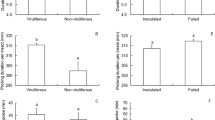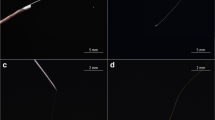Abstract
The common brown leafhopper Orosius orientalis (Hemiptera: Cicadellidae) is a polyphagous vector of a range of economically important pathogens, including phytoplasmas and viruses, which infect a diverse range of crops. Studies on the plant penetration behaviour by O. orientalis were conducted using the electrical penetration graph (EPG) technique to assist in the characterisation of pathogen acquisition and transmission. EPG waveforms representing different probing activities were acquired from adult O. orientalis probing in planta, using two host species, tobacco Nicotiana tabacum and bean Phaseolus vulgaris, and in vitro using a simple sucrose-based artificial diet. Five waveforms (O1–O5) were evident when O. orientalis fed on bean, whereas only four waveforms (O1–O4) and three waveforms (O1–O3) were observed when the leafhopper fed on tobacco and on the artificial diet, respectively. Both the mean duration of each waveform and waveform type differed markedly depending on the food substrate. Waveform O4 was not observed on the artificial diet and occurred relatively rarely on tobacco plants when compared with bean plants. Waveform O5 was only observed with leafhoppers probing on beans. The attributes of the waveforms and comparative analyses with previously published Hemipteran data are presented and discussed, but further characterisation studies will be needed to confirm our suggestions.





Similar content being viewed by others
References
Backus EA, Habibi J, Yan F, Ellersieck M (2005) Stylet penetration by adult Homalodisca coagulata on grape: electrical penetration graph waveform characterization, tissue correlation, and possible implications for transmission of Xylella fastidiosa. Ann Entomol Soc Am 98:787–813
Ballantyne B (1968) Summer death of beans. Agric Gaz NSW 79:486–489
Calatayud PA, Seligmann CD, Polania MA, Bellotti AC (2001) Influence of parasitism by encyrtid parasitoids on the feeding behavior of the cassava mealybug Phenacoccus herreni. Entomol Exp Appl 98:271–278
Gatehouse AMR, Boulter D, Hilder VA (1992) Potential of plant-derived genes in the genetic manipulation of crops for insect resistance. In: Gatehouse AMR, Boulter D, Hilder VA (eds) Plant genetic manipulation for crop protection. CAB International, Wallingford, pp 135–153
Giordanengo P (2009) EPG-Calc 4.8, a php program to calculate EPG parameters. Université de Picardie Jules Verne, Amiens, France. http://www.u-picardie.fr/PCP/UTIL/epg.php
Grylls NE (1979) Leafhopper vectors and the plant disease agents they transmit in Australia. In: Maramorosch K, Harris KF (eds) Leafhopper vectors and plant disease agents. Academic Press, New York, pp 179–214
Harding RM, Teakle DS (1985) Mycoplasma-like organisms as causal agents of potato purple top wilt in Queensland. Aust J Agr Res 36:443–449
Harrewijn P, Kayser H (1997) Pymetrozine, a fast-acting and selective inhibitor of aphid feeding. In situ studies with electronic monitoring of feeding behaviour. Pestic Sci 49:130–140
Harrewijn P, Piron PGM, Ponsen MB (1998) Evolution of vascular feeding in aphids: an electrophysiological study. Proc Exp Appl Entomol 9:29–34
Helson GAH (1950) Yellow dwarf of tobacco in Australia V. Transmission by Orosius argentatus (Evans) to some alternative host plant. Aust J Agr Res 1:144–147
Helson GAH (1951) The transmission of witches broom virus disease of lucerne by the common brown leafhopper, Orosius argentatus (Evans). Aust J Sci Res Ser B 4:115–124
Hill AV, Mandryk M (1954) A study of virus diseases “big bud” of tomato and “yellow dwarf” of tobacco. Aust J Agr Res 5:617–625
Hutton EM, Grylls NE (1956) Legume ‘little leaf’, a virus disease of subtropical pasture species. Aust J Agr Res 7:85–97
Joost PH, Riley DG (2005) Imidacloprid effects on probing and settling behavior of Frankliniella fusca and Frankliniella occidentalis (Thysanoptera: Thripidae) in tomato. Entomol Exp Appl 98:1622–1629
Khan ZR, Saxena RC (1988) Probing behaviour of three biotypes of Nilaparvata lugens (Homoptera: Delphacidae) on different resistant and susceptible rice varieties. J Econ Entomol 81:1338–1345
Kimmins FM (1989) Electrical penetration graphs from Nilaparvata lugens on resistant and susceptible rice varieties. Entomol Exp Appl 50:69–79
Kimmins FM, Bosque-Perez NA (1996) Electrical penetration graphs from Cicadulina spp. and the inoculation of a persistent virus into maize. Entomol Exp Appl 80:46–49
Kindt F, Joosten NN, Tjallingii WF (2006) Electrical penetration graphs of thrips revised: Combining DC- and AC-EPG signals. J Insect Physiol 52:1–10
Kingston KB (2007) Digestive and feeding physiology of grape phylloxera (Daktulosphaira vitifoliae Fitch), PhD: Faculty of Science. Australian National University, Canberra, p 281
Lei H, van Lenteren JC, Tjallingii WF (1999) Analysis of resistance in tomato and sweet pepper against the greenhouse whitefly using electrically monitored and visually observed probing and feeding behaviour. Entomol Exp Appl 92:299–309
Lett J-M, Granier M, Grondin M, Turpin P, Molinaro F, Chiroleu F, Peterschmitt M, Reynaud B (2001) Electrical penetration graphs from Cicadulina mbila on maize, the fine structure of its stylet pathways and consequences for virus transmission efficiency. Entomol Exp Appl 101:93–109
Liu XD, Zhai BP, Zhang XX, Zong JM (2005) Impact of transgenic cotton plants on a non-target pest, Aphis gossypii Glover. Ecol Entomol 30:307–315
McLean DL, Kinsey MG (1964) A technique for electronically recording aphids feeding and salivation. Nature (London) 202:1358–1359
McLean DL, Kinsey MG (1984) The precibarial valve and its role in the feeding behavior of the pea aphid, Acyrthosiphon pisum. Bull Entomol Soc Am 30:26–31
Mesfin T, Bosque-Pérez NA (1998) Feeding behavior of Cicadulina storeyi China (Homoptera: Cicadellidae) on maize varieties susceptible or resistant to maize streak virus. African Entomol 6:185–191
Miranda MP, Fereres A, Appezzato-da-Gloria B, Lopes JRS (2009) Characterization of electrical penetration graphs of Bucephalogonia xanthophis, a vector of Xylella fastidiosa in citrus. Entomol Exp Appl 130:35–46
Osmelak JA (1986) Assessment of various insecticides for the control of the vector Orosius argentatus (Evans) (Homoptera: Cicadellidae) and tomato big bud diseases. Department of Agricultural and Rural Affairs. Research Report, pp 1–32
Peumans WJ, Van Damme EJM (1995) Lectins as plant defence proteins. Plant Physiol 109:347–352
Pilkington LJ, Gurr GM, Fletcher MJ, Nikandrow A, Elliott E (2004) Vector status of three leafhopper species for Australian lucerne yellows phytoplasma. Aust J Entomol 42:366–373
Powell KS, Gatehouse JA (1996) Mechanism of mannose-binding snowdrop lectin for use against brown planthopper in rice: rice Genetics III. In: Khush GS (ed) Proceedings of the Third International Rice Genetics Symposium. IRRI, Manila, Philippines, pp 753–758
Powell KS, Gatehouse AMR, Hilder VA, Gatehouse JA (1993) Antimetabolic effects of plant lectins and plant and fungal enzymes on the nymphal stages of two important rice pests, Nilaparvata lugens and Nephotettix cinciteps. Entomol Exp Appl 66:119–126
Prado E, Tjallingii WF (1994) Aphid activities during sieve element punctures. Entomol Exp Appl 72:157–165
Prado E, Tjallingii WF (2007) Behavioral evidence for local reduction of aphid-induced resistance. J Insect Sci 7:1–8
Seo BY, Kwon Y-H, Jung JK, Kim G-H (2009) Electrical penetration graphic waveforms in relation to the actual positions of the stylet tips of Nilaparvata lugens in rice tissue. J Asia-Pac Entomol 12:89–95
Sogawa K (1982) The rice brown planthopper: feeding physiology and host plant interactions. Annu Rev Entomol 27:49–73
Stafford CA, Walker GP (2009) Characterization and correlation of DC electrical penetration graph waveforms with feeding behavior of beet leafhopper, Circulifer tenellus. Entomol Exp Appl 130:113–129
Tjallingii WF (1978) Electronic recording of penetration behaviour by aphids. Entomol Exp Appl 24:721–730
Tjallingii WF (1985a) Electrical nature of recorded signals during stylet penetration by aphids. Entomol Exp Appl 38:177–186
Tjallingii WF (1985b) Membrane potentials as an indication for plant cell penetration by aphid stylets. Entomol Exp Appl 38:187–193
Tjallingii WF (1988) Electrical recording of stylet penetration activities, vol 2B. In: Minks AK, Harrewijn P (eds) Aphids: their biology, natural enemies and control. Elsevier, Amsterdam, pp 95–108
Tjallingii WF (2000) Comparison of AC and DC systems for electronic monitoring of stylet penetration activities by homopterans. In: Walker GP, Backus EA (eds) Principles and applications of electronic monitoring and other techniques in the study of homopteran feeding behavior. Thomas Say Publications in Entomology, Entomological Society of America, Lanham, pp 41–69
Tjallingii WF (2006) Salivary secretions by aphids interacting with proteins of phloem wound responses. J Exp Bot 57:739–745
Tjallingii WF, Gabryś B (1999) Anomalous stylet punctures of phloem sieve elements by aphids. Entomol Exp Appl 91:97–103
Tjallingii WF, Hogen Esch TH (1993) Fine structure of aphid stylet routes in plant tissue in correlation with EPG signals. Physiol Entomol 18:317–328
Tjallingii WF, Garzo E, Fereres A (2010) New structure in cell puncture activities by aphid stylets: a dual-mode EPG study. Entomol Exp Appl 135:193–207
Trębicki P, Harding RM, Powell KS (2009) Antimetabolic effects of Galanthus nivalis agglutinin and wheat germ agglutinin on nymphal stages of the common brown leafhopper using a novel artificial diet system. Entomol Exp Appl 131:99–105
Trębicki P, Harding RM, Rodoni B, Baxter G, Powell KS (2010a) Diversity of Cicadellidae in agricultural production areas in the Ovens Valley, Northeast Victoria, Australia. Aust J Entomol 49:213–220
Trębicki P, Harding RM, Rodoni B, Baxter G, Powell KS (2010b) Seasonal activity and abundance of Orosius orientalis (Hemiptera: Cicadellidae) at agricultural sites in Southeastern Australia. J Appl Entomol 134:91–97
Trębicki P, Harding RM, Rodoni B, Baxter G, Powell KS (2010c) Vectors and alternative hosts of Tobacco yellow dwarf virus in southeastern Australia. Ann Appl Biol 157:13–24
van Helden M, Tjallingii WF (2000) Experimental design and analysis in EPG experiments with emphasis on plant resistance research. In: Walker GP, Backus EA (eds) Principles and applications of electronic monitoring and other techniques in the study of Homopteran feeding behavior. Thomas Say Publications in Entomology, Entomological Society of America, Lanham, pp 144–171
Walker GP, Janssen JAM (2000) Electronic recording of whitefly (Homoptera: Aleyrodidae) feeding and oviposition behaviour. In: Walker GP, Backus EA (eds) Principles and applications of electronic monitoring and other techniques in the study of Homopteran feeding behavior. Thomas Say Publications in Entomology, Entomological Society of America, Lanham, pp 172–200
Will T, Kornemann SR, Furch ACU, Tjallingii WF, van Bel AJE (2009) Aphid watery saliva counteracts sieve-tube occlusion: a universal phenomenon? J Exp Biol 212:3305–3312
Will T, Tjallingii WF, Thönnessen A, van Bel AJE (2007) Molecular sabotage of plant defense by aphid saliva. Proc Natl Acad Sci USA 104:10536–10541
Acknowledgments
This research was funded by Horticulture Australia Limited and the Tobacco Research and Development Corporation with in-kind support from the Department of Primary Industries (DPI), Victoria, Australia. The assistance of Dr Kim Andrews (DPI Rutherglen), Gary Baxter (DPI Ovens) and Lucy Tran-Nguyen (Charles Darwin University, Australia) is gratefully acknowledged.
Author information
Authors and Affiliations
Corresponding author
Additional information
Handling Editor: Guy Smagghe.
Rights and permissions
About this article
Cite this article
Trębicki, P., Tjallingii, W.F., Harding, R.M. et al. EPG monitoring of the probing behaviour of the common brown leafhopper Orosius orientalis on artificial diet and selected host plants. Arthropod-Plant Interactions 6, 405–415 (2012). https://doi.org/10.1007/s11829-012-9192-5
Received:
Accepted:
Published:
Issue Date:
DOI: https://doi.org/10.1007/s11829-012-9192-5




